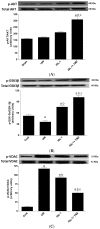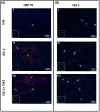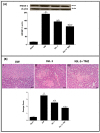GSK3β and VDAC Involvement in ER Stress and Apoptosis Modulation during Orthotopic Liver Transplantation
- PMID: 28282906
- PMCID: PMC5372607
- DOI: 10.3390/ijms18030591
GSK3β and VDAC Involvement in ER Stress and Apoptosis Modulation during Orthotopic Liver Transplantation
Abstract
We investigated the involvement of glycogen synthase kinase-3β (GSK3β) and the voltage-dependent anion channel (VDAC) in livers subjected to cold ischemia-reperfusion injury (I/R) associated with orthotopic liver transplantation (OLT). Rat livers were preserved in University of Wisconsin (UW) and Institute Georges Lopez (IGL-1) solution, the latter enriched or not with trimetazidine, and then subjected to OLT. Transaminase (ALT) and HMGB1 protein levels, glutamate dehydrogenase (GLDH), and oxidative stress (MDA) were measured. The AKT protein kinase and its direct substrates, GSK3β and VDAC, as well as caspases 3, 9, and cytochrome C and reticulum endoplasmic stress-related proteins (GRP78, pPERK, ATF4, and CHOP), were determined by Western blot. IGL-1+TMZ significantly reduced liver injury. We also observed a significant phosphorylation of AKT, which in turn induced the phosphorylation and inhibition of GSK3β. In addition, TMZ protected the mitochondria since, in comparison with IGL-1 alone, we found reductions in VDAC phosphorylation, apoptosis, and GLDH release. All these results were correlated with decreased ER stress. Addition of TMZ to IGL-1 solution increased the tolerance of the liver graft to I/R injury through inhibition of GSK3β and VDAC, contributing to ER stress reduction and cell death prevention.
Keywords: ER stress; GSK3β; IGL-1 preservation solution; VDAC; ischemia–reperfusion injury; liver transplantation; trimetazidine.
Conflict of interest statement
The authors declare no conflict of interest.
Figures





References
-
- Adam R., Delvart V., Karam V., Ducerf C., Navarro F., Letoublon C., Belghiti J., Pezet D., Castaing D., le Treut Y.P., et al. Compared efficacy of preservation solutions in liver transplantation: A long-term graft outcome study from the European Liver Transplant Registry. Am. J. Transplant. 2015;15:395–406. doi: 10.1111/ajt.13060. - DOI - PubMed
MeSH terms
Substances
LinkOut - more resources
Full Text Sources
Other Literature Sources
Medical
Research Materials
Miscellaneous

